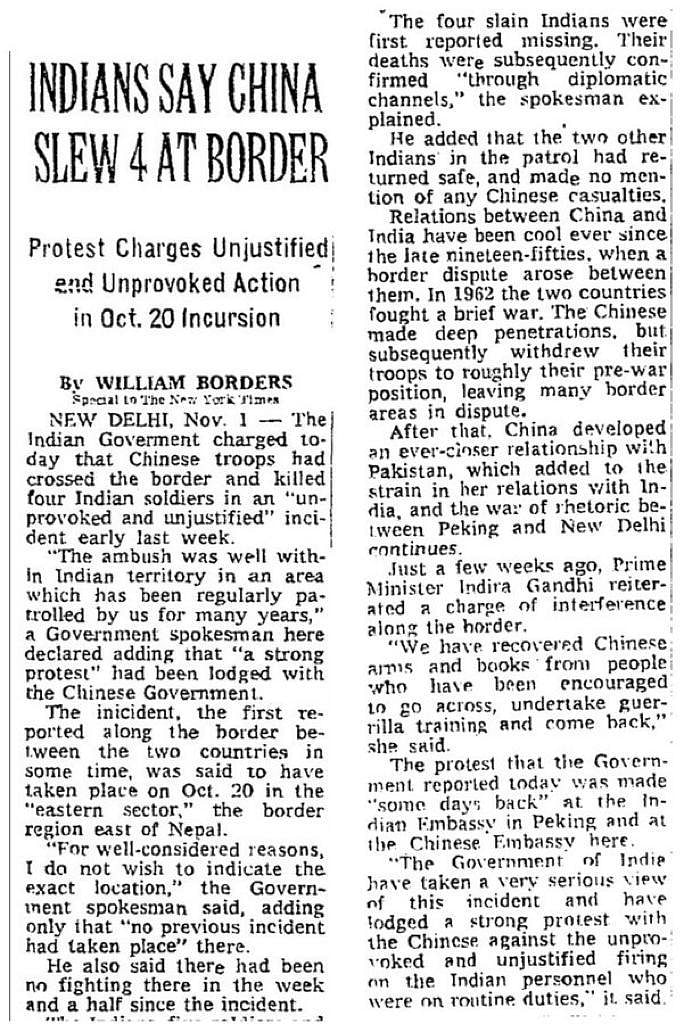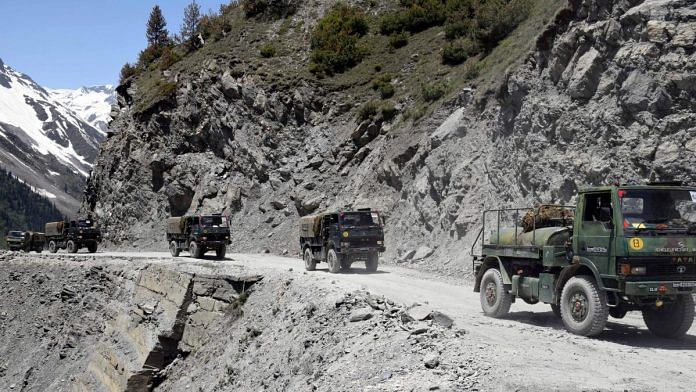New Delhi: Three Indian soldiers were killed in action following a “violent face-off” with Chinese troops Monday night in the Galwan Valley, marking the first instance of violent India-China border clash in nearly 45 years.
While the two sides have had several standoffs along the Line of Actual Control (LAC) over the past four decades, the last time Indian soldiers lost their lives due to border dispute with China was in 1975.
Back then, Chinese forces had crossed over into the Indian territory at Tulung La in Arunachal Pradesh and ambushed a patrol of Assam Rifles jawans, killing four of them.
One tends to remember the 1967 clash in Sikkim, which according to some estimates led to the death of 80 Indian and several Chinese soldiers, first when violent India-China border clashes are discussed. But before the latest standoff at Galwan, the 1975 ambush by Chinese forces remains the last instance when Indian soldiers died at the LAC.
“We often remember 1967, but to say that was the last firing, and that what happened eight years later was some sort of accident does not square with the facts. It was an ambush, plain and simple, and four of ours lost their lives,” Nirupama Rao, former Indian foreign secretary and ambassador to China, told The Hindu.
Also read: Why the serene Pangong lake lies at the heart of India-China border dispute in Ladakh
Three versions of 1975 Arunachal ambush
Unlike the 1967 clashes, the 1975 one in Arunachal remains relatively poorly documented, but there are some sources that help shed light on what might have transpired.
According to Saurabh Vashist, a Boston-based researcher of Sino-Indian relations, there are essentially three versions of the 1975 episode.
“There is the Indian version, there is a Chinese version and there is one that was mentioned in great detail in a US state department cable,” he told ThePrint.
Officially, India claimed on 20 October 1975, Chinese forces had crossed over into Indian territory in south of Tulung La, and ambushed Assam Rifles jawans. The Chinese also fired at them, resulting in four deaths.
“The ambush was well within Indian territory in an area, which has been regularly patrolled by us for many years,” an Indian government official had told The New York Times back then. The official also said India had lodged a “strong protest” with the Chinese government.

Meanwhile, China confirmed on 3 November that the incident that took place on the border on 20 October had led to the death of four Indian soldiers, but placed the responsibility of the casualties on India, according to French newspaper La Monde.
According to the Chinese version, it had shot at Indian soldiers only in “self-defense”. “A group of Indian soldiers are said to have crossed the ‘line of control’ and to shoot personnel at the civilian post at China,” China’s Ministry of Foreign Affairs had claimed.
“The ministry issued a protest note on October 22 to India’s charge d’affaires in Beijing, and informed him that during the ‘self-defense response’, station personnel ‘had killed four Indian soldiers, but that the Chinese side was ready at any time to let the Indian side bring back the bodies of the killed soldiers’,” noted the La Monde report, outlining the Chinese version of the 1975 episode.
US State Department cable backed Indian version
The third version of the 1975 ambush comes from a US State Department cable, which was made public by Wikileaks. It seemed to back the Indian version.
According to the cable, in 1975, the “Chinese ambush was sprung 500 meters south of Tulung La”, on the Indian side of the LAC. The cable quotes a senior Indian military official who claimed the Chinese had moved a company to the pass and detached a platoon, which erected stone walls on the Indian side of the pass. And it is from these positions, the Chinese fired rounds at the Indian patrol, the cable stated.
The Indian patrol had six jawans — four of them went ahead in a leading position, and the remaining two stayed back and escaped, according to the Indian official. The four jawans that went ahead were killed during Chinese fire.
“The US State Department cable does back the Indian claims but does give more details. Some in India have in subsequent years claimed that the troops were lost in the fog and may have crossed over. However, the state department cable does not back that claim. It clearly states that a Chinese company moved south of the pass,” Boston researcher Vashist said.
In 1975, Sikkim had just become a part of India, and “tensions between India and China were quite high at the time as China saw Sikkim joining India as an annexation”, he remarked.
Also read: India expects ‘forward movement’ soon in resolving Ladakh border standoff with China




China is economically down. Due to this, it has to invoke aggressive Nationalism, among it’s people. On such occasions PLA, strays in Indian territory. This they did in 1962, when cultural revolution did not yield any economic fruits. While India was making rapid strides in Planned development and becoming self sufficient. They did so in 1967, when India was at its peak of green revolution and their communist ideology was failing. They did it in 1975 when Sikkim became the part of India….and now when Covid-19 has shattered it’s economy. A second Tianamen square like situation is brewing inside China, as people are seeing a failing and weak regime. Eventually it might break-up into Tibet, Xinjiang, Inner Mongolia and Manchuria.
India needs to prepare. With PLA showing no restrain and Pakistan’s recent investment in military, it seems like something is cooking up. Right now India is surrounded by ill-wishers and our so called two faced allies cannot be counted on. Russia for one will not support India against China. This has been quite evident in their demand for China to be a part of the G-7 summit.
Furthermore, it seems like Wuhan virus was a planned move. Weakening your enemy before going for the final blow. Now, these are just speculations from the comforts of my room.